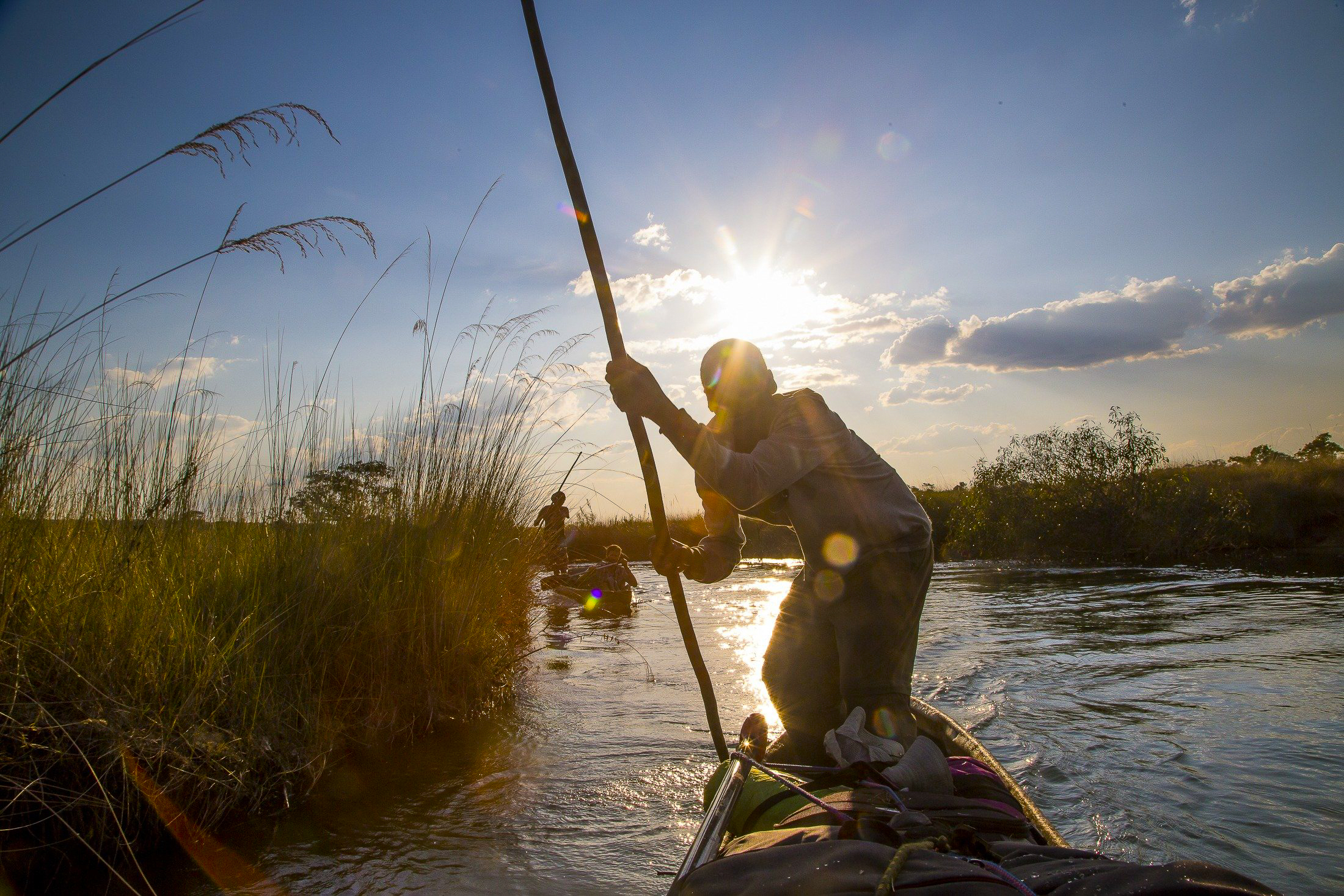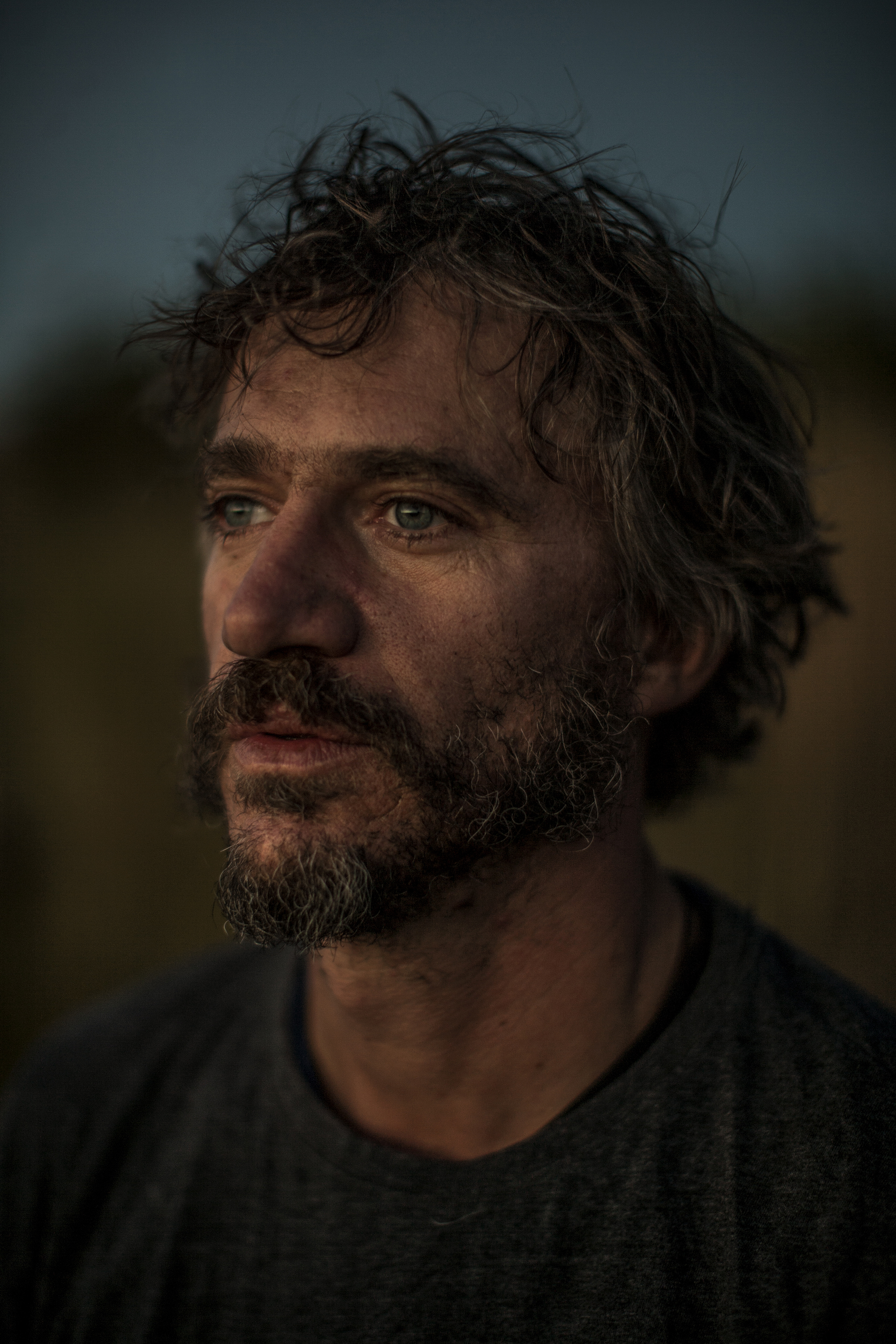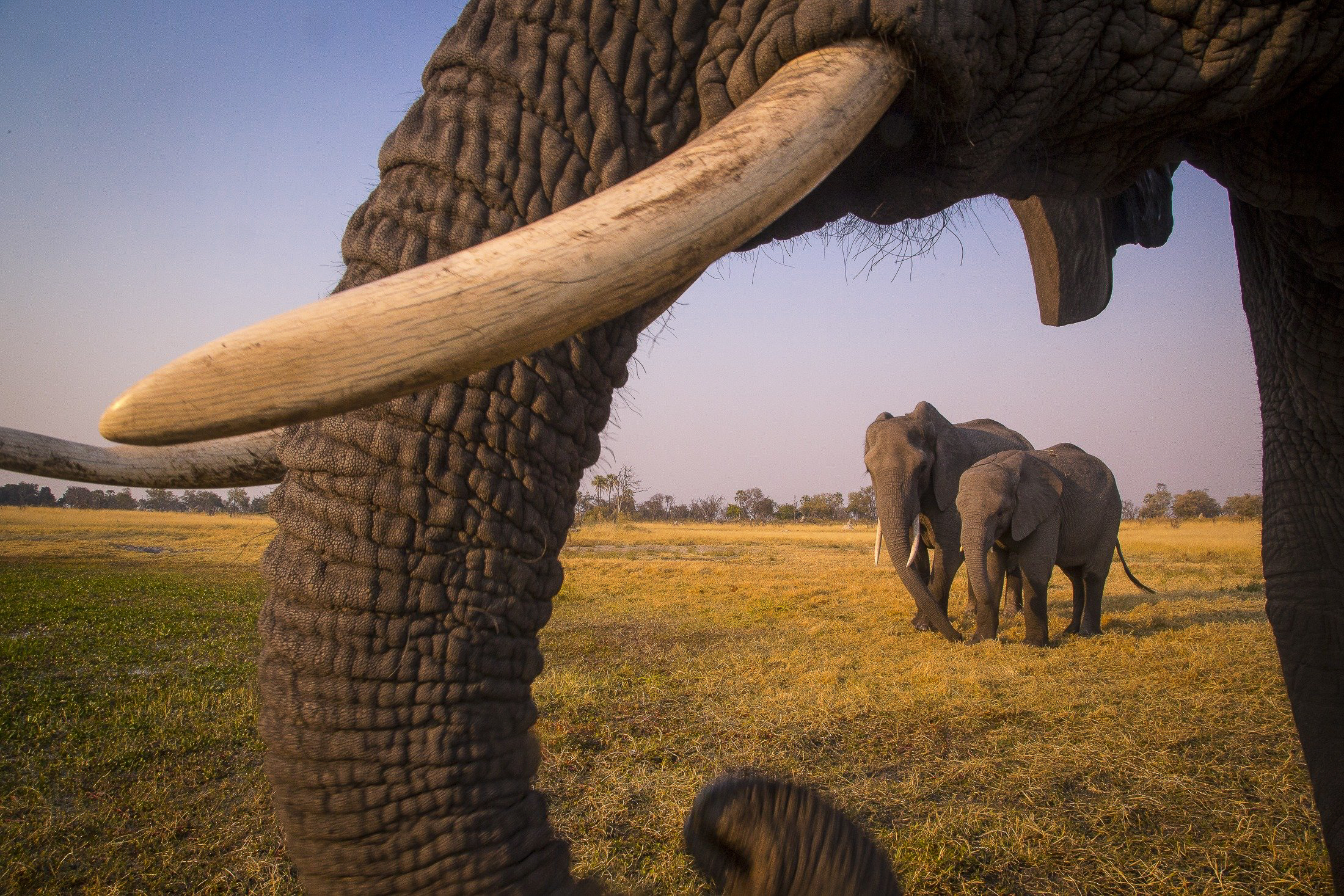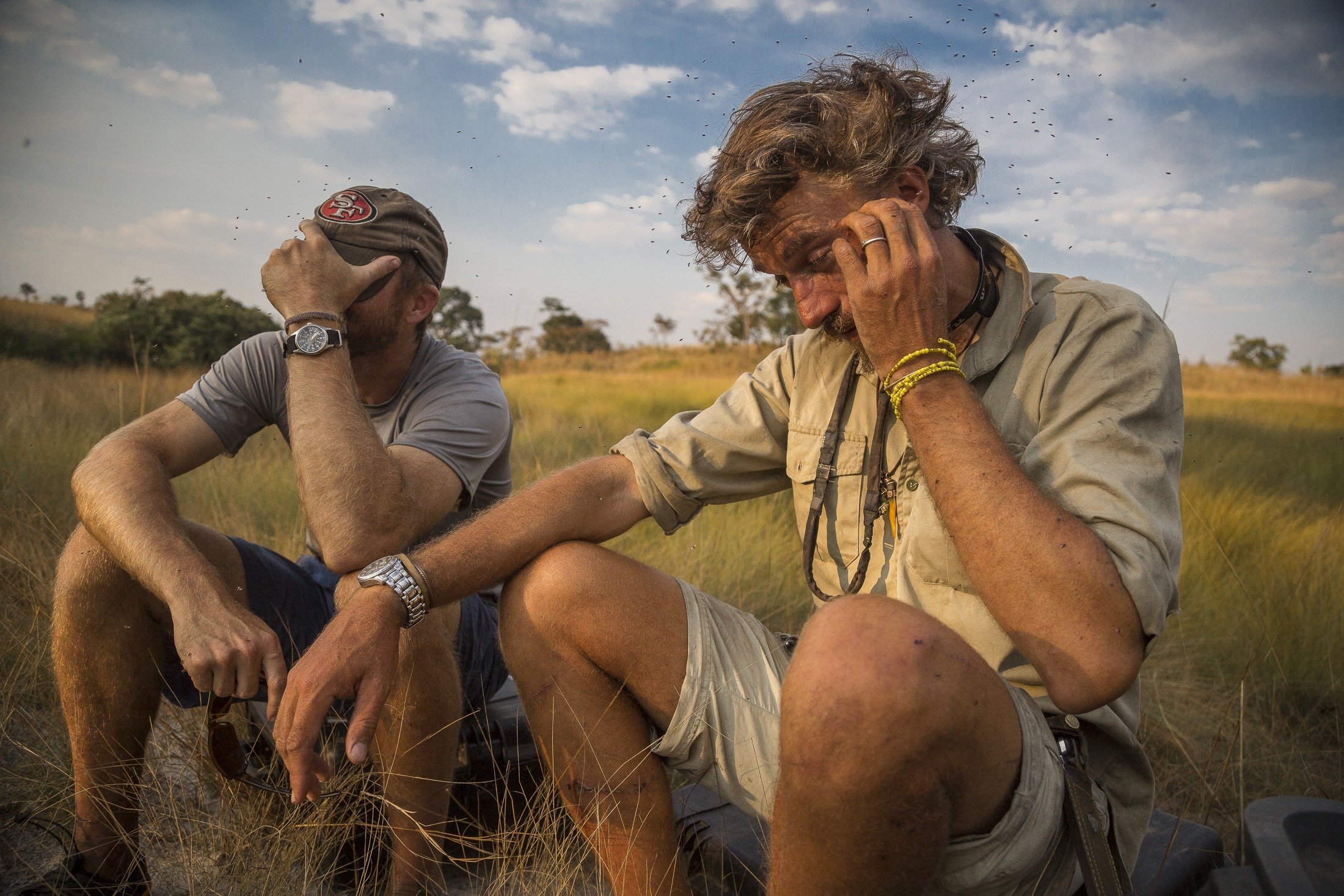
The heat of the day is intense. It’s dry and concentrated, no humidity to be found in northwestern Botswana. As beads of sweat slip down necks and across overheated scalps, Steve Boyes, a South African ornithologist and conservationist, sits at a broad table, tearing at a loaf of sweet bread.
People drift in and out of the open living room at the Khwai Tented Camp in the middle of the Okavango Delta. Some are heading off to their cabins for siesta, others wander over to a u-shaped couch that looks out onto a wide expanse of grass, hippos guffawing in the distance. Boyes is talking about humanity’s future.
“Look,” he says, swallowing, “the way I see it is, we’ve got about 10 years to figure our stuff out, and then in 50 years, depending on how that goes, we’re either all going to be wandering around in white robes, enlightened, or dealing with an apocalyptic hell.”
“Like Mad Max,” I suggest.
“Yes, exactly,” he rips another piece of bread. “Exactly. That’s why I do what I do.”
Boyes, who first encountered the Okavango Delta when he studied Meyer’s parrots for his Ph.D. fieldwork, has made it his life’s mission to conserve one of the last truly wild areas on the African continent — a place with a remarkably high concentration of elephants, lions, cheetahs, and birds. But a place that’s also starting to show the effects of human intervention.
That mission has led him down some fascinating roads, not least of which is his latest role as the star of the upcoming feature film Into The Okavango (which premieres on NatGeo WILD on Friday, December 14 at 9 p.m. ET). The film follows Boyes and his team of biologists, local guides, and international explorers as they set out to the source of Angola’s Cuito River, one of the main arteries of the delta, and embark on a months-long journey into the heart of the Okavango. The goal was to take stock of the health of the river and determine how best to protect the Okavango and its source waters from human activity in the coming years. But the journey was complicated by the turmoil of post-civil war Angola, a nation grappling with an unstable economy and remnants of a brutal conflict. Add to that an entire portion of the trip where scientists and crew had to drag their mokoros (dug-out canoes) along dry land for miles and a run-in with a hippo. These challenges threatened to derail the entire mission.
The trek — at turns wildly dangerous, heart-wrenching, and even triumphant — becomes so much more than field work by the time the team makes their way back into the heart of the Botswanan wetlands. Though the team tracks the health of the delta by counting bird populations, and there’s something delightful about periodic shouts of “squacco!” throughout the film, by the end Boyes’s passion becomes expansive, all-encompassing.
“There are very few moments in our lives that bring us into the present,” Boyes says in the beginning of the film. “The experience of being in one of the most remote places in Africa, the feeling of being cut off from all of those securities and those things we control; casting off into this wilderness.”

To get to the Okavango Delta from the U.S., you first take a flight to Johannesburg, South Africa. Seventeen hours, give or take, depending on if you make a stopover in Accra or not. Then from Johannesburg, you fly two hours to Maun, a small city in northwestern Botswana, smack in the middle of the Kalahari Desert, just on the edge of the Okavango. Finally, once you’ve gone through customs and done the whole dance, you walk to an airfield and climb into a 10-seater—the type of plane that shudders with every gust of wind and makes you feel like this could be it: the plane to take you down in a blaze of glory.
But instead of crashing, fifteen minutes into that herky-jerky flight, you start to see the dry yellow of Maun fade and, slowly, the bloom of green. Veins of water stretch and snake around, shimmering in the sunshine; from up here, you can see where the water carves endless paths in the flood season, curves and gullies, byways and broad highways. And then there’s the spider-webbing all around, the animal paths from one waterway to another.
Every year, the Okavango, which is made up of permanent marshes and seasonal floodplains, experiences massive flooding, transforming it into a shock of green, a lush oasis. Just as it’s at its most parched, water comes creeping in from sources hundreds of miles away, feeding and sustaining all manner of wildlife. And when you’re flying into the Okavango, it’s hard to determine: where does earth meet sky? There’s no clear delineation, only a melting, fading one into another. No edge. This place is so flat that it feels as if you can see into nothingness, into a place that hasn’t yet been mapped. Into the unknown.
But as Boyes knows so well, the Okavango Delta’s history and ecology, its circadian rhythm, its struggles are written on its very skin. Struggles that may help us to better understand human impacts on wild areas.
Visiting, you almost immediately begin to understand the mysticism and the reverence with which Boyes speaks about wilderness.

Trying to get to know Boyes is a little bit like trying to get to know the Okavango. It takes time and patience to learn how to read what is in front of you. Months before an alarming UN Climate Change report effectively confirms Boyes’s Mad Max theory, the lanky scientist sits at a camp near the Khwai River, at the northwestern border of the Moremi Game Reserve.
We’re surrounded by yellow: sand, grass, a distinct, dusty haze in the sky. Maps of water tables, graphs, and charts outlining fault lines and elevation in the region are situated around him
“My challenge is to think bigger than the delta,” he says. Which is a sentiment easier said than done considering what he says next: “When I’m at home in Capetown, I close my eyes, and I’m here.”
Boyes’s connection to the delta is spiritual. He drinks the water and describes it as sweet. He maneuvers his mokoro with a push-pole like it’s an extension of his arm. But still, he says, “What’s happening here is happening everywhere. Wildlife is being destroyed.”
The bigger picture then, for Steve Boyes, is the bigger picture for all of us. While his work focuses heavily on this massive hand-shaped spit of land — tracking its health via bird counts, using mokoros to get around, doing international advocacy work, you name it — what he does is bigger than the delta. But why should Americans, some 7,500 miles removed from the Okavango, care? After all, statistically speaking, most Americans will never see this place: while 28.1 percent of visitors to Botswana in 2015 were American, that’s only 40,124 people. About 42 percent of Americans hold passports, but of those of us who do travel internationally, only about four percent ever visit the African continent.
To boot, it’s not exactly as if people in the U.S. are devoid of our own problems, what with a presidential administration hellbent on keeping out immigrants and refugees and stripping just about anyone who doesn’t fit into their definition of normal of any semblance of civil rights. In other words: why care about a place that has nothing to do with us? Why not batten down the hatches and focus on ourselves?
That, to Boyes, is the golden question. “If I had an answer, I’d tell you,” he says.
Maybe the answer is that Americans aren’t so far removed from the fate of the Okavango after all. An ocean separates us, but history can tell us about our connection. The Okavango is suffering, in large part, due to American intervention. The Angolan civil war, which started in 1975 and didn’t end until around 2002, started just after the African country gained independence from Portugal. And what was, on one level, a power struggle between two Angolan factions angling to take over, was actually a proxy war between the United States and the Soviet Union at the height of the Cold War. Even after the Cold War ended, Angola’s conflict raged on, doing unspeakable damage to its people and its land. And now, the country is, in a manner of speaking, playing developmental catch-up to the rest of the world, all the while damaging its own land in order to do so. And that damage is trickling down into the Okavango.
The tendrils (and consequences) of American politics reach far, like a fungal network: unseen on the surface but surging underground. That’s not Western guilt, it’s an easy truth to arrive at.

As I venture through the delta with Boyes and his team, I find that caring about this place is so much more than something born from sanctimony or guilt. If anything, the connections between the US and the Okavango are less concrete, more important and transcendent than that. It’s about what wildness does to us as humans and the need to protect that part of our species.
“I want to change people’s minds about wilderness in general,” Boyes says. He lists off all the wild places in the U.S. that come to mind: Yosemite, the Rockies, all the great stretches of trees and animal life that dwarf human existence and remind us that we’re part of, rather than owners of, the earth.
***
On our last night at Khwai, we’re heading back to camp from a game drive and an afternoon drifting through back channels of the river in mokoros. It’s dark out, the only light coming from the moon, stars, and the lights on the truck. Everyone in the truck is rowdy, joking around about what animal they connect most with. Boyes is sitting in the front of the truck, half-turned to listen to the conversation.
“What would you be, Steve?” I ask. “What animal do you feel a soul connection with?”
He goes quiet for a moment, thinking. Then he turns his whole body toward the group.
“Here’s a story: I was walking home one night, big flashlight in hand, and I came across a jaguar in my path. She was big, and she was ready.” He regales us with the details: what it was like to, in that moment, realize his life was not in his own hands. How he had to use his heavy Maglite flashlight to hit her when she lunged at him.
We all chatter, Oh my god, that’s terrifying.
And Boyes nods, his eyes go wide. It feels as if he’s no longer in the truck with us, but looking at the jaguar again. “Yes, it was,” he stops his thought. Then he looks up. “Now that is power.”
This trip was hosted by NatGeo Wild. You can learn more about the Uproxx press trip/hosting policy here.






